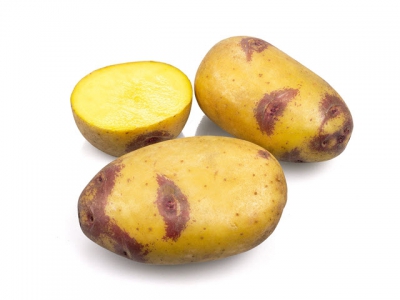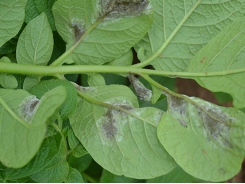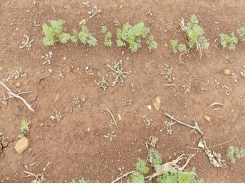Potato tuber moth and other spud pests

Many pests target potatoes but most of these occur very occasionally and are likely to do minimal damage.
There is one, however, that can become a real problem – the potato tuber moth. The moth is narrow, about 10mm long and a mottled grey – and it’s more easily spotted in the early evening. It has a very rapid life cycle, and you can get six generations on a crop. The moths, which live for about a week, lay up to 200 eggs. These are placed singly on young leaves, or on the ground under the plants.
Tunnels
The larvae then enter the leaves and begin to tunnel into the leaf between the upper and lower epidermis. The tunnels differ from those made by the leaf miner, which start off as thin tunnels and curve all around the leaf, gradually becoming larger. Unlike the leaf miner, the tuber moth remains in one area of the leaf. When they become of age, the larvae drop off the leaf onto the ground.
They enter loose soil, where each spins a cocoon and pupates. The cocoon usually has particles of soil incorporated into the silk. After about a week, the moths emerge and the cycle begins again. When the potatoes start to die back at maturity, the moths seek out the cracks in the soil which develop as the tubers expand.
Entering these cracks, they lay their eggs on the tubers and the larvae then start mining into the tubers, often just under the skin or tunnelling right into the flesh. The longer the crop stays in the ground, the more damage is done. This is why it’s important to do ridging to close cracks while the crop is growing. Of course, potatoes in storage are also vulnerable.
Parasitic wasps
This species also attacks other members of the potato family, including tomatoes and brinjals. The likelihood of an infestation is thus proportionate to host plants in the area, whether you plant one or two crops a year and even if you leave damaged potatoes in a rubbish heap after removing them from the pack house.
Several parasitoids (parasitic wasps) attack tuber moths, but one in particular is extremely effective. In this case, the wasp lays a single egg into the tuber moth larvae. The wasp egg divides to become about 70 larvae, which hatch a couple of days after pupating in the shell of the caterpillar. The wasp can thus increase extremely rapidly and keep damage to a minimum. This is another good reason to use insecticides which don’t harm these beneficials.
Other pests
Sometimes you’ll find bollworm or semi-looper larvae on the potato leaves, but spraying isn’t usually necessary unless the numbers are such that serious defoliation occurs. Aphids are another common pest – but they’re more likely to spread viruses than do physical damage. Unless there’s a large population on young plants, natural enemies are usually sufficient to keep aphid numbers under control.
Ladybirds are especially useful in this regard, as both the adult and larvae consume vast amounts in a day. A pest which can, virtually unnoticed, do quite a lot of damage, is the millipede. More of a problem for small-scale farmers, millepedes burrow into the soil and eat into the tubers, making them unmarketable. The problem is that since the tubers are underground, the damage isn’t seen until lifting.
If large numbers of these pests are seen in the area before planting, make sure that they’re controlled with a cutworm bait before planting. Another pest also likely to only really be a problem for small-scale farmers is the false chinch bug. These grey stink bugs are a few millimetres in length. They go around in swarms and can breed in patches of weeds and invade a crop rather suddenly. They cause plants to wilt when large numbers are present. I’ve only had this problem on one occasion. Use a ‘soft’ systemic product if spraying is required.
Có thể bạn quan tâm
Phần mềm

Phối trộn thức ăn chăn nuôi

Pha dung dịch thủy canh

Định mức cho tôm ăn

Phối trộn phân bón NPK

Xác định tỷ lệ tôm sống

Chuyển đổi đơn vị phân bón

Xác định công suất sục khí

Chuyển đổi đơn vị tôm

Tính diện tích nhà kính

Tính thể tích ao hồ




 Leafy crop vs fruiting crop the balancing act
Leafy crop vs fruiting crop the balancing act  Carrots: get your numbers right!
Carrots: get your numbers right!